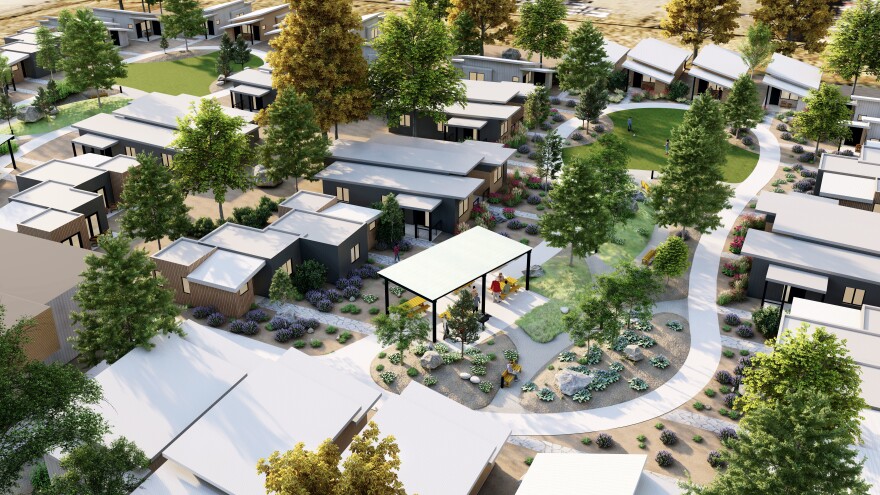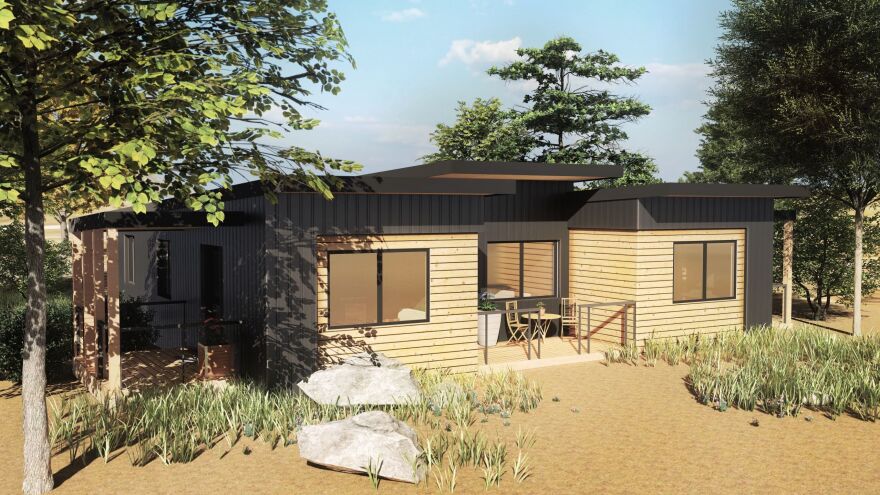Salt Lake City's city council voted in favor of a project to build a small community of tiny homes for people experiencing chronic homelessness, in a project that organizers hope could be a model for other cities.
The organization behind the effort is The Other Side Village, which is now in the process of submitting building permits to start development. It hopes to start housing people in the summer of 2023.
Samuel Grenny, director of communications for the village, joined the project shortly after it started a year and a half ago.
"It is very overwhelming. It was a lot of work we put in leading up to it," Grenny told NPR over the phone. "It's just really, really gratifying."
The village will provide permanent housing to people who are chronically unsheltered, which means they've spent a cumulative year or more on the streets within the last three years. The Other Side Village is specifically targeting those who struggle with mental illness or drug addiction, since they're the ones who have the hardest time finding and maintaining housing.

The community will initially feature 60 fully-equipped cottage-style homes, split into smaller neighborhoods of 30 homes. It will have a bodega, and plans to start a donut shop and succulent plant arrangement business. These stores will provide employment opportunities for the villagers, so they can become financially self-sufficient while connecting with the surrounding community.
The planners hope to eventually build an open air event center and auditorium for world class musical talents.
"The village will live or die based on whether it is a place that people are excited and eager to come," Grenny said.
Working with the neighborhood to assuage concerns
Initially, the village faced significant opposition. The space allotted for the homes is in District Two on the west side of Salt Lake City. In a phone call with NPR, city council member Alejandro Puy, who represents the district, said it's one of the few in Utah with a minority majority. And it's used to feeling unheard.
"In my district alone, there are several state facilities for those that are in prison or some sort of custody, several halfway houses, drug treatment facilities, older shelters," Puy said, adding that people are frustrated with the lack of economic investment in the district.

Puy said his constituents liked the concept of the village and agreed the city needs to do something about homelessness, but were concerned it could be yet another burden on the west side. Puy described a community rich in culture and diversity that just needs some financial support to emerge.
"I don't think this will be a success unless there is a connection with the community," Puy said. So, the district and The Other Side Village have worked to address each other's concerns.
Grenny said they made dozens of adjustments to aesthetics, the program and its amenities based on these conversations.
For example, measuring crime in the surrounding community will allow the Other Side to make sure the village doesn't make the area more dangerous. Puy knows the Other Side runs a tight ship, he said, but the neighbors feel safer now that the village agreed to have 24-hour security. It's also starting with just 60 homes, with the plan to scale up to their originally proposed 430 homes.
The Other Side Village is diligently recording data to track its successes and failures, with the aim to be replicable around the country. Grenny said their team will package their plans to hand off to other cities and offer training – and, in turn, hopes to learn from those cities' innovations.
Broader solutions for homelessness are needed
Truly addressing homelessness really comes down to housing prices, Grenny said. The median rental price in Salt Lake City is $1,800, which is up $205 from last November, according to Zillow.
"We've never tried to say that we can be a long term solution to the causal drivers," Grenny said. "What we can do is demonstrate for this specific population of folks, [...] we have a model that can actually help them get in sustained housing and become members of the community, rather than being isolated."

But that can also have a systemic impact. The organizers hope that many villagers will be able to have a louder political voice by gaining the resources to vote, participate in activism and even run for office. Grenny thinks that can drive further solutions.
The Other Side has recruited unhoused people, for whom it then helped find transitional housing, to help develop the village — because they know better what unhoused people need.
"If you're not including them in the process, you're not going to create a real solution," he said. "The dream of the Other Side Village is to empower people to make and hold their own standards."
The organization also hired a third party company to knock doors in the neighborhood and poll people, revealing that about 60% of community members were in favor of the project, according to Grenny.
At city council meetings, he said some west siders have been vocal that they think the village could be an economic advantage for their district. It made the previously unhoused members of his team emotional.
"They've experienced some pretty overwhelming support, and they walked away from the city council meetings close to tears because of the number of people who went to bat for people who are unsheltered," Grenny said. "I think that was a pretty unique experience for them."
Copyright 2022 NPR. To see more, visit https://www.npr.org.




